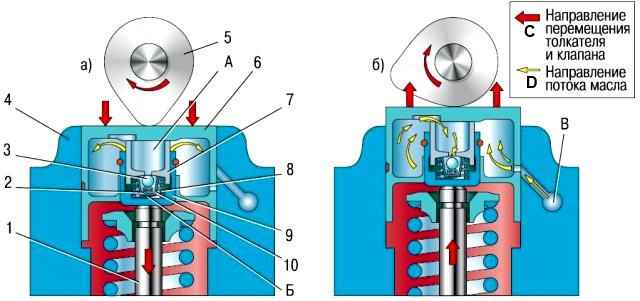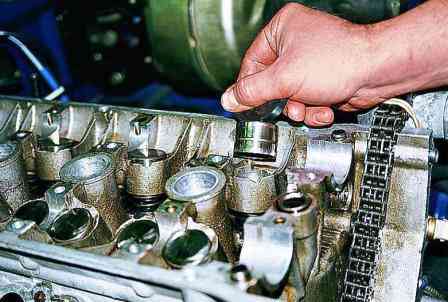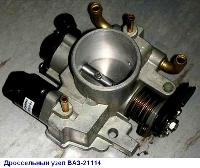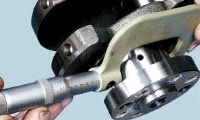Hydraulic pushers of the ZMZ-409 engine, made in the form of cylindrical pushers and located between the camshaft and valves, combine two functions: transferring force from the camshaft to the valves and eliminating gaps in their drive
The operation of the hydraulic pusher is based on the principle of incompressibility of engine oil, which constantly fills the internal cavity of the hydraulic pusher during engine operation and moves its plunger when a gap appears in the valve drive.
This ensures constant contact of the pusher (valve drive lever) with the camshaft cam without play.

This eliminates the need to adjust the valves during maintenance.
The principle of operation of the hydraulic pusher is shown in fig. 1.
Oil under pressure necessary for the operation of the hydraulic pusher is supplied to its internal cavities A and B from the channel B of the engine lubrication system through the side hole in the pusher 6, made in the annular groove of its cylindrical surface.
When the valve 1 is closed, the pusher 6 (through the plunger 7) and the sleeve 9 are pressed by the expanding force of the spring 8, respectively, to the cam 5 of the camshaft and the end of the valve stem.
The pressure in the A and B cavities is the same, the check valve 3 of the hydraulic compensator is pressed against the seat in the plunger 7 by the spring 2 - there are no gaps in the valve mechanism.
When the camshaft rotates, the cam 5 runs into the pusher 6, moving it and the associated plunger 7.
Moving the plunger 7 in the sleeve 9 leads to a sharp increase in pressure in the B cavity.
Despite small oil leaks through the gap between the plunger and the sleeve, the pusher 6 and sleeve 9 move in one piece and open valve 1.
With further rotation of the camshaft, the cam 5 reduces the pressure on the pusher 6 and the oil pressure in the B cavity becomes lower than in the A cavity.
Return valve 3 opens and allows oil to pass from A cavity, connected to the engine oil line, into B cavity.
The pressure in the B cavity increases, the sleeve 9 and the plunger 7, moving relative to each other, select the gap in the valve mechanism.
The pressure of the oil supplied to the hydraulic pushers is regulated by a special valve installed in the cylinder head.
Since after the engine is stopped, oil drains from the channels coming from the oil pump into the oil sump, and the channels for supplying oil to the hydraulic pushers remain filled, air locks may form in the cavities of the latter after the engine is started.
To eliminate them, calibrated compensation holes are provided in the engine oil supply channels, which provide automatic purge of the cavities of the hydraulic pushers.
In addition, compensation holes allow you to slightly reduce the pressure of the oil entering the hydraulic pushers at a high engine speed.
When the pressure in the cavity of the hydraulic pusher can become so high that its pusher, leaning on the back of the camshaft cam, will slightly open the valve at a moment that does not correspond to the valve timing.
Almost all malfunctions of hydraulic pushers are diagnosed by the characteristic noise emitted by the gas distribution mechanism in various engine operating modes.

Valve noise
Noise from valves can sometimes be eliminated by slightly turning the spring or valve around the longitudinal axis. To do this, do the following.
- 1. Rotate the crankshaft until the valve making the noise starts to open slightly.
- 2. Turn the spring a little and the valve will turn at the same time.
- 3. Start the engine. If the noise persists, repeat operations 1 and 2.
- 4. If turning the spring and the valve does not give the desired result, check the condition of the spring and measure the gaps between the valve stems and the guide bushings (see "Replacing the cylinder head gasket ZMZ-409").
Remove larger than nominal clearances.
If the valve and spring are in good condition, and the knock of the valves is still heard when the engine is running, the hydraulic pusher is faulty.
Replace it like this:
Disconnect the wire from the negative terminal of the battery.
Remove the camshafts from the cylinder head supports (see "Removing and installing ZMZ-409 camshafts").
Remove the hydraulic tappet from the cylinder head seat.

It is more convenient to remove the hydraulic pusher using a strong magnet or suction cup.
Before installing, put the new hydraulic tappet in a container with engine oil, press the tappet sleeve several times to remove air and fill it with oil.
Lubricate the socket in the block head with engine oil and install the hydraulic pusher in the socket.
The rest of the hydraulic pushers are replaced in the same way.
Install the camshaft and timing gear parts in the reverse order of removal.











